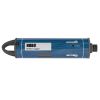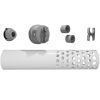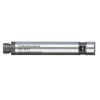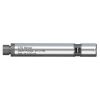HOBO Dissolved Oxygen Sensor
Features
- User-replaceable DO cap lasts 2 years or more
- High accuracy measurements, even without calibration
- Get salinity-adjusted DO directly when used with conductivity sensor (W-CT or W-CTD)
- Free ground shipping
- Expedited repair and warranty service
- Lifetime technical support
- More
The dissolved oxygen sensor is an interchangeable sensor that works with HOBO MX800 Series Water Loggers to measure dissolved oxygen and temperature. The DO sensor can be attached directly to the fully submersible MX801 model, or attached via cable to the direct read MX802 model, which doesn’t require having to pull the sensor out of the water to download data.
When this sensor is connected to a HOBO MX800 logger that also has a conductivity or CTD sensor attached, the logger can record salinity-adjusted DO directly. With this sensor attached to the HOBO MX802 direct read model, the logger can calculate DO percent saturation directly. When used with fully submersible HOBO MX801 model, a barometric logger data file (from either an MX802 or MX2001 logger) is needed to calculate DO percent saturation, for post-processing in the HOBOconnect app. In waters with changing salinity, the logger must also have a salinity sensor attached or you will need an MX800 salinity data file to get DO percent saturation.
- User-replaceable DO cap lasts 2 years or more
- High accuracy measurements, even without calibration
- Get salinity-adjusted DO directly when used with conductivity sensor (W-CT or W-CTD), no need for post-processing
- Direct DO percent saturation data, no need for post-processing (when used with MX802)
- Easy calibration with included calibration boot – saves time
- 1” diameter for use in narrow wells (with cable to MX802 above the well)
- PVC housing holds up in saltwater
- (1) Dissolved oxygen sensor
- (1) Dissolved oxygen sensor cap
- (1) Calibration boot and sponge
In The News
Data-Driven Advocacy on the Lower Deschutes River
Like many freshwater environments, the Deschutes River in Oregon is under pressure from development, pollution, and climate change. Many rivers, streams and lakes in the Deschutes Basin do not meet Oregon water quality standards –where state water quality monitoring assesses levels of bacteria, pH, dissolved oxygen, temperature, and fine sediment. Hannah Camel is the Water Quality Coordinator for the Deschutes River Alliance (DRA), a non-profit organization that focuses on the health of the lower 100 miles of the Deschutes River–the area most affected by human intervention. As a data-driven organization, the DRA has benefited from the installation of two NexSens X2 data loggers.
Read MoreExpanding the Port Everglades: Real-Time Monitoring of Water Quality Conditions from Planned Dredging Operation
The Port Everglades in Broward County, Florida, serves large trade vessels and cruiseliners and incoming and outgoing recreational boaters. However, as cargo ships become larger, the port must expand. A dredging project led by the US Army Corps of Engineers will substantially deepen and widen the port's navigation channel to accommodate larger Panamax cargo ships and modern cruise liners. As a result of this project, a large amount of sediment will be displaced into the water column. This suspended sediment may settle outside of the project area, burying benthic organisms like corals, and possibly carrying harmful particulates to other regions. [caption id="attachment_39497" align="aligncenter" width="2560"] A CB-950 and CB-25 deployed on site at Port Everglades.
Read MoreIt’s Time to React to Water Quality: Proteus Multiparameter Probe aboard NexSens Buoy
Water quality monitoring is essential for safeguarding public health, protecting ecosystems, and ensuring the sustainability of water resources. Contaminants such as industrial pollutants, agricultural runoff, and sewage discharge can severely impact aquatic life and pose serious risks to human health if left unchecked. Traditionally, water quality monitoring has been a slow and labor-intensive process, requiring samples to be collected, transported to a lab, and analyzed—a process that can take days. However, with the advancement of real-time sensor technology, environmental agencies, researchers, and industries can now monitor water quality instantly.
Read More


























